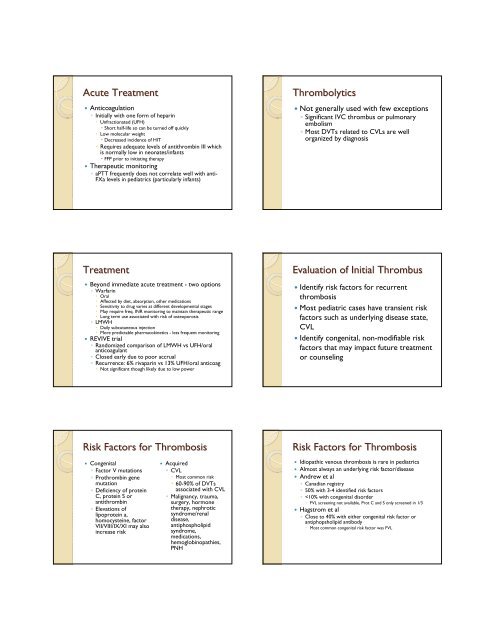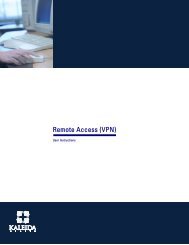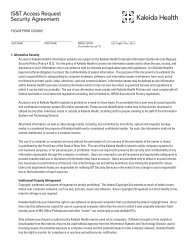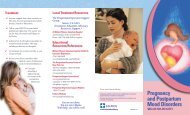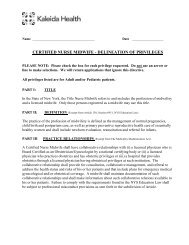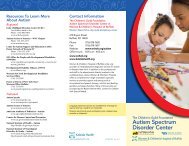Pediatric Venous Thrombosis Venous Thrombosis ... - Kaleida Health
Pediatric Venous Thrombosis Venous Thrombosis ... - Kaleida Health
Pediatric Venous Thrombosis Venous Thrombosis ... - Kaleida Health
You also want an ePaper? Increase the reach of your titles
YUMPU automatically turns print PDFs into web optimized ePapers that Google loves.
Acute Treatment<br />
• Anticoagulation<br />
◦ Initially with one form of heparin<br />
• Unfractionated (UFH)<br />
• Short half-life so can be turned off quickly<br />
• Low molecular weight<br />
• Decreased incidence of HIT<br />
• Requires adequate levels of antithrombin III which<br />
is normally low in neonates/infants<br />
• FFP prior to initiating therapy<br />
• Therapeutic monitoring<br />
◦ aPTT frequently does not correlate well with anti-<br />
FXa levels in pediatrics (particularly infants)<br />
Thrombolytics<br />
• Not generally used with few exceptions<br />
◦ Significant IVC thrombus or pulmonary<br />
embolism<br />
◦ Most DVTs related to CVLs are well<br />
organized by diagnosis<br />
Treatment<br />
• Beyond immediate acute treatment - two options<br />
◦ Warfarin<br />
• Oral<br />
• Affected by diet, absorption, other medications<br />
• Sensitivity to drug varies at different developmental stages<br />
• May require freq. INR monitoring to maintain therapeutic range<br />
• Long term use associated with risk of osteoporosis<br />
◦ LMWH<br />
• Daily subcutaneous injection<br />
• More predictable pharmacokinetics - less frequent monitoring<br />
• REVIVE trial<br />
◦ Randomized comparison of LMWH vs UFH/oral<br />
anticoagulant<br />
◦ Closed early due to poor accrual<br />
◦ Recurrence: 6% rivaparin vs 13% UFH/oral anticoag<br />
• Not significant though likely due to low power<br />
Evaluation of Initial Thrombus<br />
• Identify risk factors for recurrent<br />
thrombosis<br />
• Most pediatric cases have transient risk<br />
factors such as underlying disease state,<br />
CVL<br />
• Identify congenital, non-modifiable risk<br />
factors that may impact future treatment<br />
or counseling<br />
Risk Factors for <strong>Thrombosis</strong><br />
• Congenital<br />
◦ Factor V mutations<br />
◦ Prothrombin gene<br />
mutation<br />
◦ Deficiency of protein<br />
C, protein S or<br />
antithrombin<br />
◦ Elevations of<br />
lipoprotein a,<br />
homocysteine, factor<br />
VII/VIII/IX/XI may also<br />
increase risk<br />
• Acquired<br />
◦ CVL<br />
• Most common risk<br />
• 60-90% of DVTs<br />
associated with CVL<br />
◦ Malignancy, trauma,<br />
surgery, hormone<br />
therapy, nephrotic<br />
syndrome/renal<br />
disease,<br />
antiphospholipid<br />
syndrome,<br />
medications,<br />
hemoglobinopathies,<br />
PNH<br />
Risk Factors for <strong>Thrombosis</strong><br />
• Idiopathic venous thrombosis is rare in pediatrics<br />
• Almost always an underlying risk factor/disease<br />
• Andrew et al<br />
◦ Canadian registry<br />
◦ 50% with 3-4 identified risk factors<br />
◦


